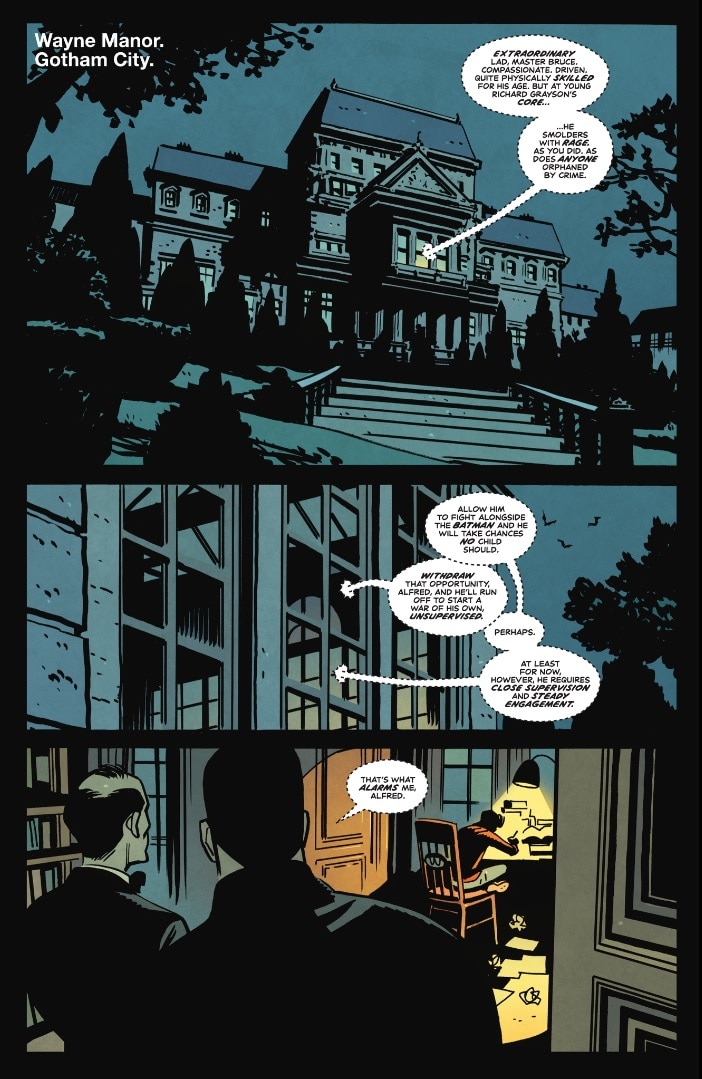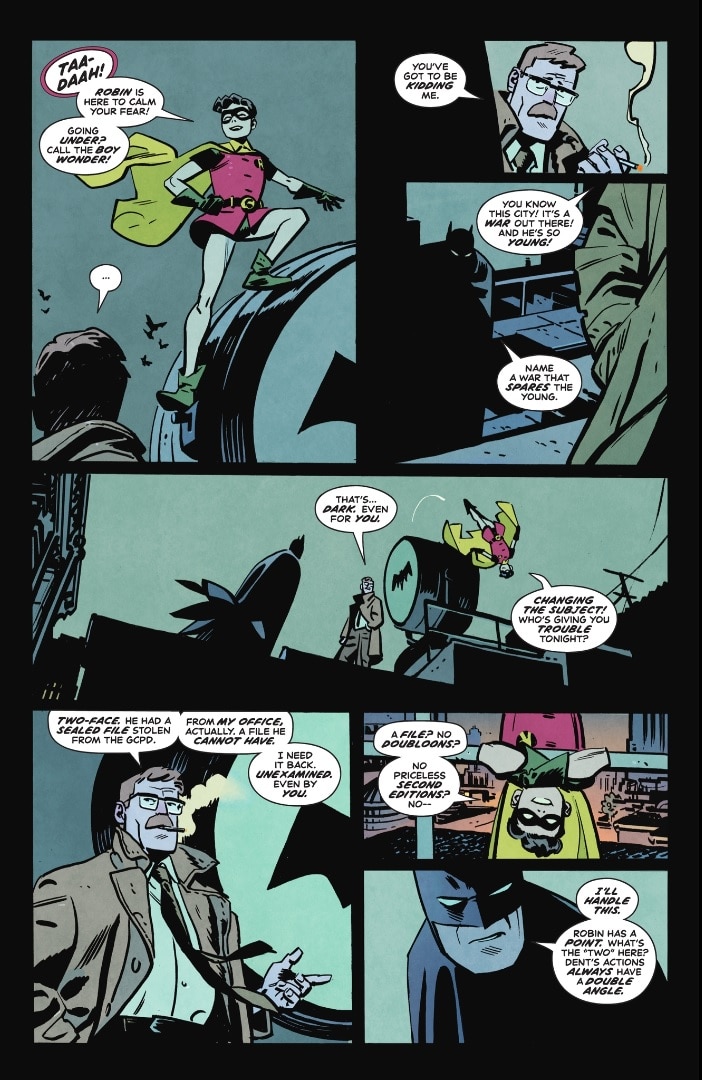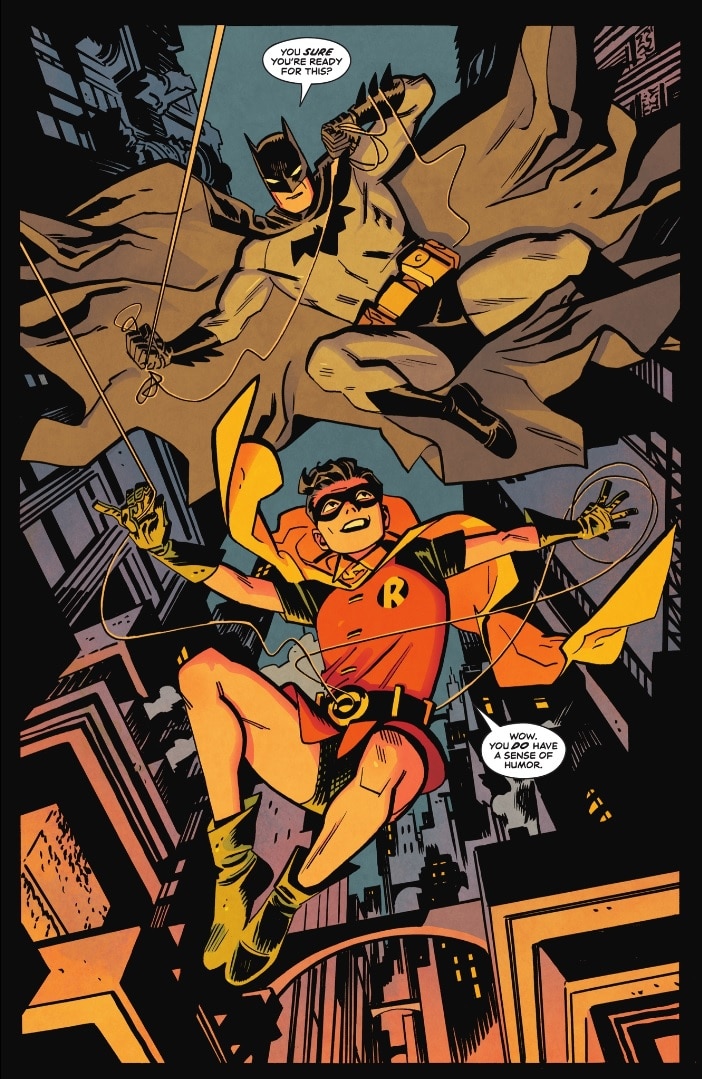Gotham City is a busy place, with a lot going down each and every week. In this monthly column, Joshua Lapin-Bertone helps you stay on top of it all by letting you know what you should be paying attention to within the Bat-Family…and why.
The Batman and Robin partnership is a part of our cultural DNA. It’s one of the most famous pairings in the world of fiction. They’re so iconic, that when you say the name “Dynamic Duo,” almost everyone knows who you’re referring to. And make no mistake, Batman and Robin earned that title. However, I think their notoriety has caused us to overlook some issues with the partnership.
If you heard that someone was putting a preteen boy on a battlefield, you would probably be horrified. That horror would grow once you found out the child had seen their parents murdered mere weeks before and that they will be going up against the worst killers the world has seen. Most normal people would be very concerned and rightfully so.
This is one of the things I like about Mark Waid and Chris Samnee’s Batman and Robin: Year One. The currently in progress limited series focuses on the early days of Dick Grayson’s time as Robin and isn’t afraid to address some of these hard questions. Throughout the first issue, multiple people call Batman out for recruiting a child into his war on crime.

“Allow him to fight alongside Batman and he will take chances no child should,” Alfred warns.
When Commissioner Gordon meets Robin, he reacts with utter shock. “You know this city!” he exclaims to Batman. “It’s a war out there! And he’s so young!”
Even Two-Face chides the Dark Knight for bringing a child to their battle. “What is it, Bring-Your-Kid-to-Hell Day,” he quips.
The morality and wisdom of Batman taking on a young boy as a partner has mostly been sidestepped over the years. When Robin first appeared in 1940’s Detective Comics #38, the issue of Dick Grayson’s age was never a question. Storytelling sensibilities were different back then, and the comic didn’t take the time to address child endangerment. It was a pulp adventure story written for a different audience.
Retellings of Robin’s origin have avoided the issue in various ways. For example, the New 52 reboot softened the blow by making Dick Grayson fifteen. The 1995 film Batman Forever avoided the issue by introducing a college-aged Dick.

It’s worth noting that Dick Grayson’s age when he first became Robin varies with each retelling. Some comics imply that he was as young as 7 (1942’s Batman #10), 8 (1984’s New Teen Titans #39), 10 (1987’s Secret Origins #13) or 12 (Batman Family #11). For what it’s worth, Batman and Robin: Year One #1 doesn’t give an age, but Dick looks like he’s somewhere between 11-14.
In Waid’s script, Bruce gives a few different justifications for using Dick as a partner. “Withdraw that opportunity, Alfred, and he’ll run off to start a war of his own unsupervised,” Bruce tells his loyal butler. It’s an interesting point that’s backed up by some versions of Robin’s origin.
The Batman: The Animated Series two-parter “Robin’s Reckoning,” 1995’s Robin Annual #4, and 2012’s Nightwing #0 all show Dick attempting to hunt for criminals on his own before becoming Batman’s partner. Plus, that’s more or less what Bruce did after his parents were murdered. While Bruce didn’t suit up as Batman until he was an adult, he did make a childhood vow to wage war on criminals. Either way, there is plenty of evidence to back up the justification that Bruce gave Alfred.
However, his exchange with Jim Gordon makes the case a much different way. When Gordon asks Batman about taking a child under his wing, the Dark Knight dismisses his concerns. “Name a war that spares the young,” Batman tells Jim.
“That’s…dark. Even for you,” Gordon replies. Robin immediately gets them to change the subject before the matter can be probed any further.

Looking at the scene, it seems like Batman is being evasive with Gordon on the matter. It would be hard to justify Robin’s role as a kid partner without going into his background and potentially giving Gordon the information he needs to deduce their identities, so Batman just dismissed his concerns without addressing them.
However, the exchange could also be read another way. Perhaps Batman did that because he knows Gordon’s concerns aren’t entirely baseless. Deep down, Bruce has his doubts about putting Dick in the battlefield. How could he not? He’s been able to talk himself into it and come up with excuses to give to Alfred, but Gordon is forcing him here to face those doubts. And when faced with them, Batman does what he does with all ‘death traps’ and escapes.
Was it a mistake to let Dick Grayson become Robin? I think history has proven that Bruce made the right decision. But taking a young boy into a dangerous place like Gotham is risky, to say the absolute least. Yes, serving as the sidekick to Gotham’s hero will provide some truly unique learning experiences, but it’s also full of pitfalls. Future issues of Batman and Robin: Year One will explore both sides of the experience. After all, Bruce and Dick didn’t become a Dynamic Duo overnight.
Batman and Robin: Year One #1 by Mark Waid, Chris Samnee and Matheus Lopes is available in print and as a digital comic book, and can be read on DC UNIVERSE INFINITE.
Joshua Lapin-Bertone writes about TV, movies and comics for DC.com, is a regular contributor to the Couch Club and writes our monthly Batman column, "Gotham Gazette." Follow him on Twitter at @TBUJosh.
NOTE: The views and opinions expressed in this feature are solely those of Joshua Lapin-Bertone and do not necessarily reflect those of DC or Warner Bros. Discovery, nor should they be read as confirmation or denial of future DC plans.




















